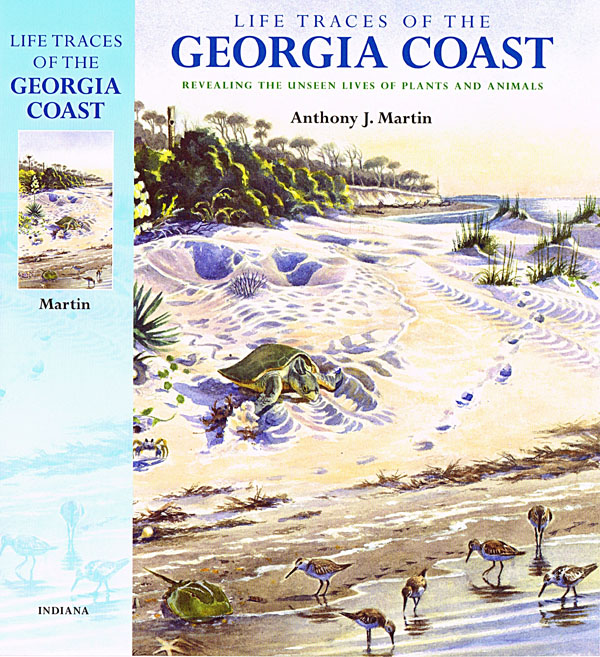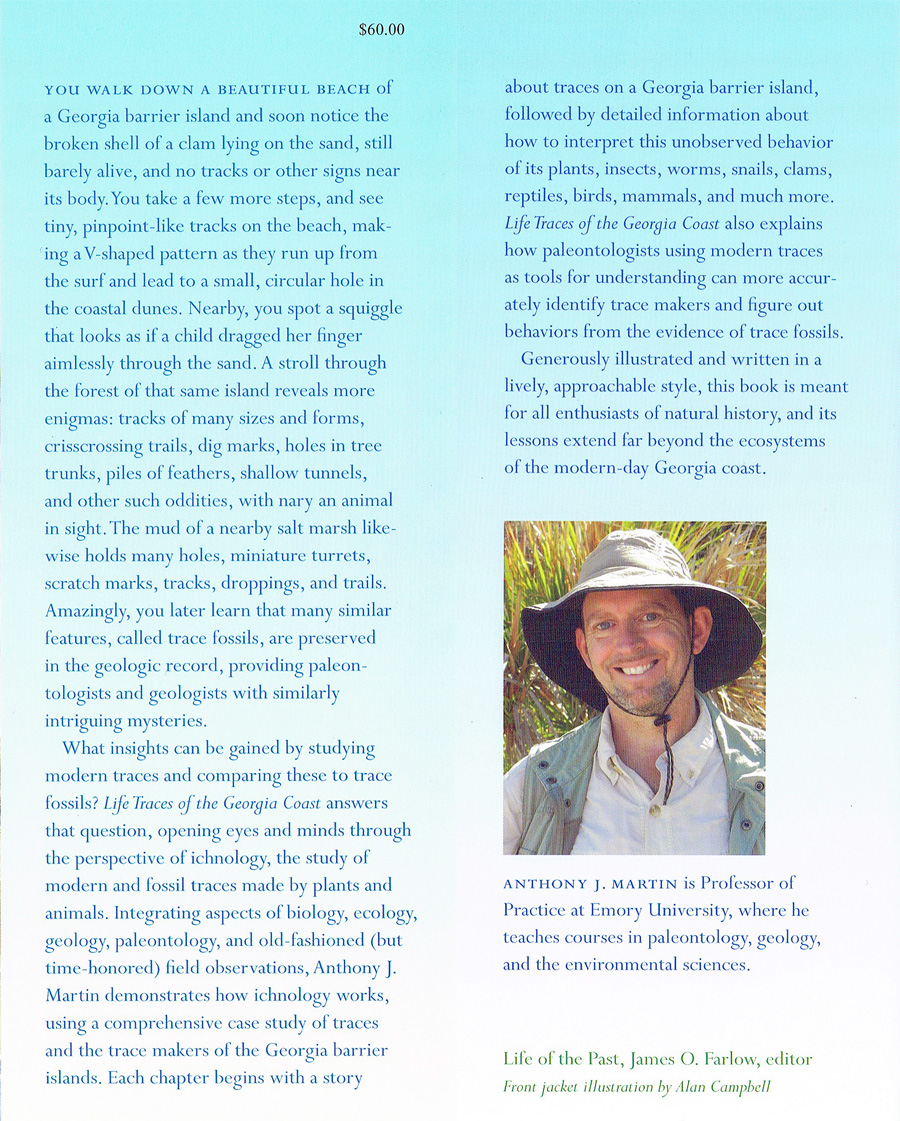After returning from a two-week vacation in California with my wife Ruth, we noticed a cardboard tube awaiting us at home. Intriguingly, the mystery package, which was only about 60 cm (24 in) long and 8 cm (3 in) wide, had been sent by Indiana University Press, the publisher of my new book, Life Traces of the Georgia Coast. We were a little puzzled by it, considering that it couldn’t possibly contain complimentary copies of the book. (As of this writing, I still have not held a corporeal representation of the book, hence my continuing skepticism that it is really published.) What was in this mystery tube?
 Front cover and spine of my new book, Life Traces of the Georgia Coast: Revealing the Unseen Lives of Plants and Animals (Indiana University Press). The book, newly released this month, is not yet in stores, but supposedly on its way to those places and to people who were kind enough to pre-order it. But if you didn’t pre-order it, that’s OK: you can get it right here, right now.
Front cover and spine of my new book, Life Traces of the Georgia Coast: Revealing the Unseen Lives of Plants and Animals (Indiana University Press). The book, newly released this month, is not yet in stores, but supposedly on its way to those places and to people who were kind enough to pre-order it. But if you didn’t pre-order it, that’s OK: you can get it right here, right now.
Upon opening it, we were delighted to find that it held ten life-sized prints of the book jacket: front cover, spine, back cover, and front-back inside flaps. The cover art, done by Georgia artist Alan Campbell, looked gorgeous, and had reduced well to the 16 X 25 cm (6 X 9″) format, retaining details of traces and tracemakers, but also conveying a nice aesthetic sense. I was also amused to see the spine had the title (of course) but also said “Martin” and “Indiana.” Although I’ve lived in Georgia for more than 27 years, I was born and raised in Indiana, so it somehow seemed fitting in a circle-of-life sort of way to see this put so simply on the book.
 Back cover of Life Traces of the Georgia Coast, highlighting a few of the tracemakers mentioned in the book – sea oats, sandhill crane, sand fiddler crab, and sea star – while also providing a pretty sunset view of primary dunes, beach, and subtidal environments on Sapelo Island. (P.S. I love that it says “Science” and “Nature” at the top, too.)
Back cover of Life Traces of the Georgia Coast, highlighting a few of the tracemakers mentioned in the book – sea oats, sandhill crane, sand fiddler crab, and sea star – while also providing a pretty sunset view of primary dunes, beach, and subtidal environments on Sapelo Island. (P.S. I love that it says “Science” and “Nature” at the top, too.)
I had no idea what the back cover might be like until seeing these prints, but I thought it was well designed, bearing a fair representative sample of tracemakers of the Georgia barrier islands: sea oats (Uniola paniculata), a sandhill crane (Grus canadensis), sand fiddler crab (Uca pugilator), and lined sea star (Luidia clathrata), as well as a scenic view of some coastal environments. I had taken all of these photos, so it was exciting to see these arranged in such a pleasing way. My only scientifically based objection is that I would have like to see it include photos of insects, worms, amphibians, reptiles, or mammals (these and much more are covered in the book), as well as a few more tracks, trails, or burrows. Granted, I suppose they only had so much room for that 6 X 9″ space, and thus I understood how they couldn’t use this space to better represent the biodiversity of Georgia-coast tracemakers and their traces. (Oh well: guess you’ll have to read the book to learn about all that.)
 Inside front and back flap material for Life Traces of the Georgia Coast, which also includes a summary of the book (written by me) and a rare photo of me (taken by Ruth Schowalter) in my natural habitat, which in this instance was on St. Catherines Island, Georgia.
Inside front and back flap material for Life Traces of the Georgia Coast, which also includes a summary of the book (written by me) and a rare photo of me (taken by Ruth Schowalter) in my natural habitat, which in this instance was on St. Catherines Island, Georgia.
I had written the summary of the book on the inside flap nearly a year ago, so it was fun to look at it with fresh eyes, almost as if someone else had written it for me. Fortunately, I banished my inner critic while reading it, and just enjoyed the sense that it likely achieved its goal, which was to tell people about the book and provoke their interest in it.
In short, this cover jacket symbolizes a next-to-last step toward the book being real in my mind. Now, like any good scientist, all I need is some independently verifiable evidence in the form of tactile data, such as a physical book in my hands. Stay tuned for that update, which I’ll be sure to share once it happens. In the meantime, many thanks to all of the staff at Indiana University Press – who I’ll mention by name next time – for their essential role in making the book happen and promoting it in this new year.
Information about the Book, from Indiana University Press
Life Traces of the Georgia Coast: Revealing the Unseen Lives of Plants and Animals, Anthony J. Martin
Have you ever wondered what left behind those prints and tracks on the seashore, or what made those marks or dug those holes in the dunes? Life Traces of the Georgia Coast is an up-close look at these traces of life and the animals and plants that made them. It tells about the how the tracemakers lived and how they interacted with their environments. This is a book about ichnology (the study of such traces), a wonderful way to learn about the behavior of organisms, living and long extinct. Life Traces presents an overview of the traces left by modern animals and plants in this biologically rich region; shows how life traces relate to the environments, natural history, and behaviors of their tracemakers; and applies that knowledge toward a better understanding of the fossilized traces that ancient life left in the geologic record. Augmented by numerous illustrations of traces made by both ancient and modern organisms, the book shows how ancient trace fossils directly relate to modern traces and tracemakers, among them, insects, grasses, crabs, shorebirds, alligators, and sea turtles. The result is an aesthetically appealing and scientifically accurate book that will serve as both a source book for scientists and for anyone interested in the natural history of the Georgia coast.
Life of the Past – Science/Paleontology
692 pp., 34 color illus., 137 b&w illus.
cloth 978-0-253-00602-8 $60.00
ebook 978-0-253-00609-7 $51.99
More information at:
http://www.iupress.indiana.edu/catalog/806767 ]http://www.iupress.indiana.edu/catalog/806767
